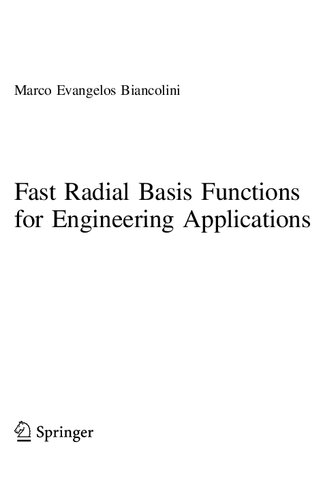

Most ebook files are in PDF format, so you can easily read them using various software such as Foxit Reader or directly on the Google Chrome browser.
Some ebook files are released by publishers in other formats such as .awz, .mobi, .epub, .fb2, etc. You may need to install specific software to read these formats on mobile/PC, such as Calibre.
Please read the tutorial at this link: https://ebookbell.com/faq
We offer FREE conversion to the popular formats you request; however, this may take some time. Therefore, right after payment, please email us, and we will try to provide the service as quickly as possible.
For some exceptional file formats or broken links (if any), please refrain from opening any disputes. Instead, email us first, and we will try to assist within a maximum of 6 hours.
EbookBell Team

4.7
16 reviewsThis book presents the first “How To” guide to the use of radial basis functions (RBF). It provides a clear vision of their potential, an overview of ready-for-use computational tools and precise guidelines to implement new engineering applications of RBF.
Radial basis functions (RBF) are a mathematical tool mature enough for useful engineering applications. Their mathematical foundation is well established and the tool has proven to be effective in many fields, as the mathematical framework can be adapted in several ways. A candidate application can be faced considering the features of RBF:
multidimensional space (including 2D and 3D), numerous radial functions available, global and compact support, interpolation/regression.
This great flexibility makes RBF attractive – and their great potential has only been partially discovered. This is because of the difficulty in taking a first step toward RBF as they are not commonly part of engineers’ cultural background, but also due to the numerical complexity of RBF problems that scales up very quickly with the number of RBF centers. Fast RBF algorithms are available to alleviate this and high-performance computing (HPC) can provide further aid. Nevertheless, a consolidated tradition in using RBF in engineering applications is still missing and the beginner can be confused by the literature, which in many cases is presented with language and symbolisms familiar to mathematicians but which can be cryptic for engineers. The book is divided in two main sections. The first covers the foundations of RBF, the tools available for their quick implementation and guidelines for facing new challenges; the second part is a collection of practical RBF applications in engineering, covering several topics, including response surface interpolation in n-dimensional spaces, mapping of magnetic loads, mapping of pressure loads, up-scaling of flow fields, stress/strain analysis by experimental displacement fields, implicit surfaces, mesh to cad deformation, mesh morphing for crack propagation in 3D, ice and snow accretion using computational fluid dynamics (CFD) data, shape optimization for external aerodynamics, and use of adjoint data for surface sculpting. For each application, the complete path is clearly and consistently exposed using the systematic approach defined in the first section.